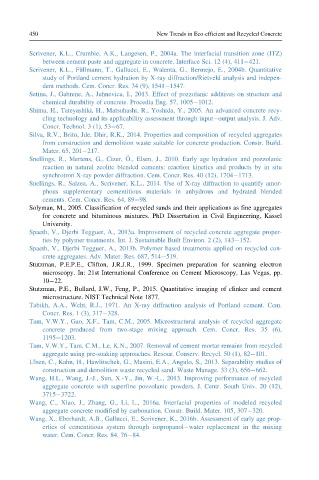Page 500 - New Trends in Eco efficient and Recycled Concrete
P. 500
450 New Trends in Eco-efficient and Recycled Concrete
Scrivener, K.L., Crumbie, A.K., Laugesen, P., 2004a. The interfacial transition zone (ITZ)
between cement paste and aggregate in concrete. Interface Sci. 12 (4), 411 421.
Scrivener, K.L., Fu ¨llmann, T., Gallucci, E., Walenta, G., Bermejo, E., 2004b. Quantitative
study of Portland cement hydration by X-ray diffraction/Rietveld analysis and indepen-
dent methods. Cem. Concr. Res. 34 (9), 1541 1547.
Setina, J., Gabrene, A., Juhnevica, I., 2013. Effect of pozzolanic additives on structure and
chemical durability of concrete. Procedia Eng. 57, 1005 1012.
Shima, H., Tateyashiki, H., Matsuhashi, R., Yoshida, Y., 2005. An advanced concrete recy-
cling technology and its applicability assessment through input output analysis. J. Adv.
Concr. Technol. 3 (1), 53 67.
Silva, R.V., Brito, Jde, Dhir, R.K., 2014. Properties and composition of recycled aggregates
from construction and demolition waste suitable for concrete production. Constr. Build.
Mater. 65, 201 217.
¨
Snellings, R., Mertens, G., Cizer, O., Elsen, J., 2010. Early age hydration and pozzolanic
reaction in natural zeolite blended cements: reaction kinetics and products by in situ
synchrotron X-ray powder diffraction. Cem. Concr. Res. 40 (12), 1704 1713.
Snellings, R., Salzea, A., Scrivener, K.L., 2014. Use of X-ray diffraction to quantify amor-
phous supplementary cementitious materials in anhydrous and hydrated blended
cements. Cem. Concr. Res. 64, 89 98.
Solyman, M., 2005. Classification of recycled sands and their applications as fine aggregates
for concrete and bituminous mixtures. PhD Dissertation in Civil Engineering, Kassel
University.
Spaeth, V., Djerbi Tegguer, A., 2013a. Improvement of recycled concrete aggregate proper-
ties by polymer treatments. Int. J. Sustainable Built Environ. 2 (2), 143 152.
Spaeth, V., Djerbi Tegguer, A., 2013b. Polymer based treatments applied on recycled con-
crete aggregates. Adv. Mater. Res. 687, 514 519.
Stutzman, P.E.P.E., Clifton, J.R.J.R., 1999. Specimen preparation for scanning electron
microscopy. In: 21st International Conference on Cement Microscopy, Las Vegas, pp.
10 22.
Stutzman, P.E., Bullard, J.W., Feng, P., 2015. Quantitative imaging of clinker and cement
microstructure. NIST Technical Note 1877.
Tabikh, A.A., Weht, R.J., 1971. An X-ray diffraction analysis of Portland cement. Cem.
Concr. Res. 1 (3), 317 328.
Tam, V.W.Y., Gao, X.F., Tam, C.M., 2005. Microstructural analysis of recycled aggregate
concrete produced from two-stage mixing approach. Cem. Concr. Res. 35 (6),
1195 1203.
Tam, V.W.Y., Tam, C.M., Le, K.N., 2007. Removal of cement mortar remains from recycled
aggregate using pre-soaking approaches. Resour. Conserv. Recycl. 50 (1), 82 101.
Ulsen, C., Kahn, H., Hawlitschek, G., Masini, E.A., Angulo, S., 2013. Separability studies of
construction and demolition waste recycled sand. Waste Manage. 33 (3), 656 662.
Wang, H.L., Wang, J.-J., Sun, X.-Y., Jin, W.-L., 2013. Improving performance of recycled
aggregate concrete with superfine pozzolanic powders. J. Centr. South Univ. 20 (12),
3715 3722.
Wang, C., Xiao, J., Zhang, G., Li, L., 2016a. Interfacial properties of modeled recycled
aggregate concrete modified by carbonation. Constr. Build. Mater. 105, 307 320.
Wang, X., Eberhardt, A.B., Gallucci, E., Scrivener, K., 2016b. Assessment of early age prop-
erties of cementitious system through isopropanol water replacement in the mixing
water. Cem. Concr. Res. 84, 76 84.

